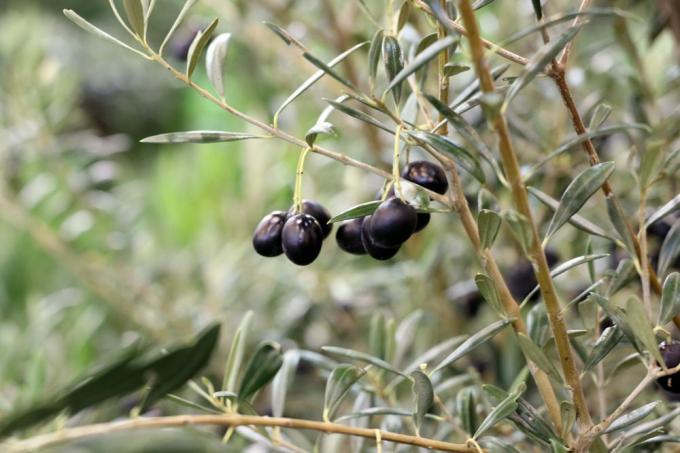
table of contents
- Fruit development
- Ideal harvest time
- Ripe olive
- Recognize unripe fruits
There are around 300 different types of olives on the market, the color of which ranges from green to black. The color says something about the degree of ripeness of the Mediterranean stone fruits. Every olive is colored green at the beginning of its development. When fully ripe, the color tones differ from violet-black to red-brown, depending on the variety. While the degree of ripeness of tree fruits is clearly recognizable, stone fruits from the trade can often only be assigned to a stage of ripeness with difficulty.
Fruit development
It takes about two to three months for the green colored stone fruits to ripen. During this process, the consistency of the pulp changes from firm to crunchy to soft. The aroma becomes increasingly mild as the bitterness and spiciness take a back seat. Unripe olives are high in polyphenols, which are beneficial to health. For the production of olive oil, the stone fruits are harvested immature, because in the course of their development the polyphenol content decreases sharply.
Ideal harvest time
Temperatures, the number of hours of sunshine and the availability of water have a decisive influence on fruit ripeness. The stone fruits are harvested in autumn after a lot of warmth and sun. In Germany, the olive tree only develops flowers and stone fruits in the wine-growing regions. Under the growing conditions here, Olea europaea bears the first olives in the course of the summer, which can be harvested for the first time from mid-November. At this time they are in the first stage of maturity. The olive fruits mature through the end of December. If the weather is unfavorable, fruit ripening can drag on into January. The stages of ripeness can easily be recognized by the color of the fruit:
- early stage: green stone fruits are firm, have a low oil content and are very bitter
- Middle stage: green-yellowish to red-violet fruits have a slightly sweet taste and are more oily
- last stage: black fruits with a soft consistency and a mild, spicy taste.
Ripe olive

When the stone fruits are ripe, they have neither a bitter nor a pungent taste. Their aroma is mildly spicy with a slightly sweet note, because the bitter substances have decomposed in the course of the fruit's ripeness. Their coloring differs depending on the variety. A deep black basic tone, which can have purple, reddish or brown nuances, is typical. The pulp and core also turn black.
Fully mature specimens are easy to pick from the tree. They can fall from the branch at any moment and take on unpleasant aromas on the ground, which is why a quick harvest is necessary. These properties are characteristic of ripe olives:
- low content of polyphenols
- higher in calories than immature specimens
- contain more saturated fat
Tip: You can recognize oil from fully ripe olives by its golden yellow color, because the harvested stone fruits no longer contain chlorophyll.
Recognize unripe fruits
Olives are often offered in stores that only appear ripe at first glance. Their black coloring is an illusion, because they did not come about through a natural ripening process. The harvest time of these specimens often falls in the early stage of ripeness when they are still green in color. They are then colored with the dye iron (II) gluconate. This increases their shelf life and changes the taste. Pay attention to the information in the list of ingredients. Black colored olives must be labeled, which you can recognize by the ingredient E 579. Another sign of colored and unripe fruits is the color of the pulp and core. If these are still green, this indicates that olives were harvested too early.
Tip: Green olives are inedible and must first be bathed in caustic soda. Then place the stone fruits in brine or vinegar and refine them with herbs.


